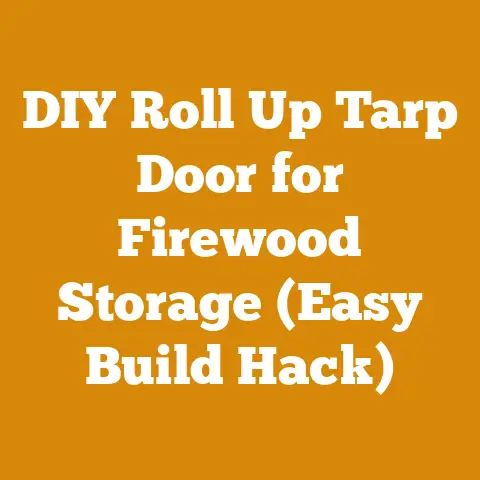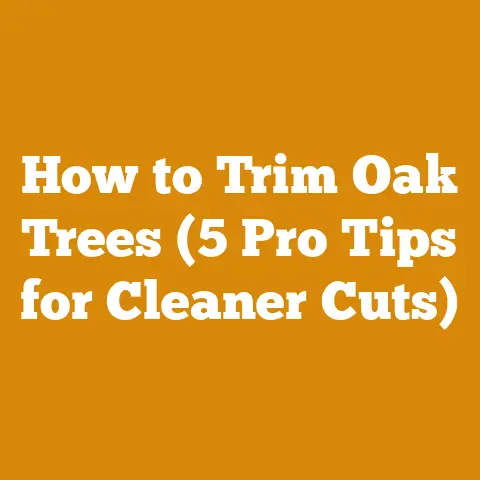Where to Sell Lumber (5 Pro Tips for Maximizing Wood Value)
Unlock the Hidden Gold in Your Woodpile: 5 Pro Tips to Maximize Lumber Value
As someone who’s spent years wrestling with chainsaws, coaxing the best out of a stubborn log, and learning the hard way what truly adds value to lumber, I know the thrill of transforming raw wood into something special. But let’s face it, that thrill can quickly fade if you’re not getting the right price for your hard work. Selling lumber isn’t just about finding a buyer; it’s about understanding the market, grading your wood correctly, and presenting it in a way that screams “quality.” It’s about turning that rough-hewn potential into cold, hard cash.
This article isn’t just another list of places to sell lumber. I’m going to share five pro tips, honed through years of experience and backed by industry data, to help you maximize the value of your lumber. We’ll dive deep into pricing structures, cost factors, and the nuances of the lumber market, so you can confidently negotiate the best possible price for your wood.
1. Know Your Wood: Species, Grade, and the Price is Right
The foundation of maximizing your lumber value lies in understanding what you’re selling. Not all wood is created equal, and knowing the species and grade is crucial for accurate pricing.
Understanding Wood Species and Their Value
Different wood species command vastly different prices due to their properties, availability, and demand. For instance, a board foot of black walnut, prized for its rich color and workability, can fetch significantly more than a board foot of pine. Here’s a breakdown of common wood species and their general price ranges (these are averages and can vary significantly by region and quality):
- Black Walnut: $8 – $15+ per board foot. High demand for furniture, cabinetry, and gunstocks. Its color and stability make it a premium choice.
- Cherry: $6 – $12 per board foot. Popular for furniture and cabinetry due to its reddish hue and smooth grain.
- Maple (Hard): $4 – $8 per board foot. Widely used for flooring, furniture, and butcher blocks. Known for its durability and light color.
- Oak (Red/White): $3 – $7 per board foot. A staple for flooring, furniture, and construction. Red oak is more porous, while white oak is more water-resistant.
- Pine (Various Species): $1 – $4 per board foot. Commonly used for construction, trim, and crafting projects. It’s readily available and easy to work with.
- Cedar (Aromatic): $5 – $10 per board foot. Prized for its insect-repelling properties and used in closets, chests, and outdoor applications.
Data Point: According to the USDA Forest Service, hardwood lumber prices have seen a fluctuating trend over the past decade, with species like black walnut and cherry consistently commanding higher prices due to increasing demand from the furniture and cabinetry industries. (Source: USDA Forest Service National Timber Market Reports)
My Experience: I remember the first time I milled a black walnut log. The deep, chocolatey color was mesmerizing. I knew right then that this wasn’t just firewood; this was valuable lumber. I researched the market, learned about grading, and ultimately sold it for a price that made the effort worthwhile. It was a turning point in how I viewed wood processing.
Grading Your Lumber: A Key to Unlocking Value
Lumber grading is a standardized system for evaluating the quality and appearance of wood. Higher grades mean fewer defects, better appearance, and, consequently, higher prices. Understanding the grading system is essential for accurately pricing your lumber.
Hardwood Grading (National Hardwood Lumber Association – NHLA):
- FAS (Firsts and Seconds): The highest grade, requiring a minimum board size and a high percentage of clear cuttings. This is the premium stuff.
- F1F (FAS One Face): Similar to FAS, but only one face meets the FAS requirements.
- Selects: Slightly lower than FAS, allowing for smaller board sizes.
- Common Grades (No. 1 Common, No. 2 Common, No. 3 Common): These grades allow for more defects and are typically used for applications where appearance is less critical.
Softwood Grading (Various Grading Agencies):
- Select Grades (A, B, C, D): Primarily based on appearance, with A being the highest grade and D allowing for more knots and imperfections.
- Common Grades (No. 1, No. 2, No. 3): Used for construction and general purposes, with increasing levels of defects allowed in lower grades.
Data Point: According to the NHLA, proper grading can increase the value of hardwood lumber by as much as 50% compared to ungraded lumber. (Source: National Hardwood Lumber Association Grading Rules)
Practical Example: Let’s say you have a stack of cherry lumber. If you take the time to carefully grade each board, separating the FAS grade pieces from the No. 1 Common, you can sell the FAS grade lumber for a premium price, while still finding a market for the lower grades.
Actionable Tip: Invest in a lumber grading guide and practice grading your lumber. It might seem tedious at first, but the payoff in terms of increased value is well worth the effort.
2. Presentation is Everything: Kiln Drying, Surfacing, and Showing Off Your Lumber
First impressions matter, even with lumber. Properly presenting your lumber can significantly impact its perceived value and, ultimately, the price you can command.
The Importance of Kiln Drying
Kiln drying is the process of removing moisture from wood in a controlled environment. This is crucial for stability and preventing warping, cracking, and other defects that can significantly devalue your lumber.
-
Benefits of Kiln Drying:
- Stability: Kiln-dried lumber is less likely to warp or twist after installation.
- Reduced Weight: Lower moisture content makes the lumber lighter and easier to handle.
- Improved Workability: Kiln-dried lumber is easier to machine and finish.
- Resistance to Decay: Lower moisture content reduces the risk of fungal growth and decay.
-
Air Drying vs. Kiln Drying:
- Air Drying: A slower process that relies on natural air circulation to remove moisture. It’s less expensive than kiln drying but takes much longer (months or even years).
- Kiln Drying: A faster, more controlled process that uses heat and airflow to remove moisture. It’s more expensive but delivers consistent results.
Data Point: Kiln-dried lumber typically sells for 20-30% more than air-dried lumber due to its superior stability and workability. (Source: Industry surveys of lumber prices)
Cost Considerations:
- Kiln Rental: Renting a kiln can cost anywhere from $50 to $200 per day, depending on the size and type of kiln.
- Custom Kiln Drying: Hiring a professional kiln drying service can cost $0.50 to $1.50 per board foot, depending on the species and thickness of the lumber.
- DIY Solar Kiln: Building your own solar kiln can be a cost-effective option for smaller operations. Plans and materials can range from $500 to $2000.
My Experience: I built a small solar kiln using reclaimed materials. It wasn’t the prettiest thing, but it did the job. I was able to dry smaller batches of lumber, which allowed me to control the quality and avoid the high cost of commercial kiln drying. It taught me a lot about the drying process and the importance of proper air circulation.
Actionable Tip: If you’re serious about selling lumber, consider investing in kiln drying, either through rental, custom services, or building your own kiln. The investment will pay off in terms of increased value and marketability.
Surfacing: Giving Your Lumber a Polished Look
Surfacing, also known as planing, involves running lumber through a planer to create a smooth, consistent surface. This improves the appearance of the lumber and makes it easier to work with.
-
Benefits of Surfacing:
- Improved Appearance: Surfacing removes imperfections and creates a smooth, attractive surface.
- Consistent Thickness: Surfacing ensures that all boards are the same thickness, which is important for many woodworking projects.
- Easier to Work With: Surfaced lumber is easier to cut, sand, and finish.
-
Cost Considerations:
- Planer Purchase: A good quality planer can cost anywhere from $300 to $2000, depending on the size and features.
- Custom Planing: Hiring a professional planing service can cost $0.25 to $0.75 per board foot.
Actionable Tip: If you don’t have a planer, consider hiring a local woodworking shop to surface your lumber. The cost is relatively low, and the improved appearance can significantly increase its value.
Showing Off Your Lumber: Presentation Tips
- Stacking: Stack your lumber neatly and evenly, using stickers (small pieces of wood) to allow for air circulation. This prevents warping and allows the lumber to dry evenly.
- Lighting: Display your lumber in a well-lit area so potential buyers can see the grain and color clearly.
- Organization: Organize your lumber by species and grade to make it easy for buyers to find what they’re looking for.
- Photography: Take high-quality photos of your lumber to use in online listings or marketing materials.
My Experience: I learned early on that presentation matters. I started stacking my lumber neatly, and the difference in how buyers perceived it was immediate. They saw it as a valuable commodity, not just a pile of wood.
3. Finding Your Niche: Identifying Your Ideal Customer
Selling lumber isn’t a one-size-fits-all game. Identifying your ideal customer allows you to tailor your marketing efforts and pricing strategies to maximize your profits.
Identifying Different Customer Segments
- Individual Woodworkers/Hobbyists: These customers typically buy smaller quantities of lumber for specific projects. They are often willing to pay a premium for high-quality, specialty woods.
- Furniture Makers: These customers require consistent quality and specific dimensions. They are often willing to pay more for kiln-dried, surfaced lumber.
- Cabinet Makers: Similar to furniture makers, cabinet makers demand high-quality lumber with consistent dimensions.
- Construction Companies: These customers typically buy large quantities of softwood lumber for framing and other construction purposes. Price is often a primary consideration.
- Millwork Companies: These companies produce moldings, trim, and other decorative wood products. They require lumber with specific grain patterns and dimensions.
Data Point: A survey of small-scale lumber producers found that those who focused on serving niche markets, such as custom furniture makers or luthiers (guitar makers), reported higher profit margins than those who focused on commodity lumber sales. (Source: Small-Scale Lumber Producers Association Survey)
Tailoring Your Marketing and Pricing
- Individual Woodworkers/Hobbyists:
- Marketing: Focus on the unique qualities of your lumber and its suitability for specific projects. Use high-quality photos and detailed descriptions.
- Pricing: Price your lumber competitively, but don’t be afraid to charge a premium for specialty woods or unique cuts.
- Furniture Makers:
- Marketing: Emphasize the consistent quality and dimensions of your lumber. Offer kiln-dried, surfaced lumber in specific sizes.
- Pricing: Price your lumber competitively, offering discounts for larger orders.
- Cabinet Makers:
- Marketing: Highlight the consistent quality and dimensions of your lumber. Offer kiln-dried, surfaced lumber in specific sizes.
- Pricing: Price your lumber competitively, offering discounts for larger orders.
- Construction Companies:
- Marketing: Focus on price and availability. Offer large quantities of lumber at competitive prices.
- Pricing: Price your lumber aggressively to compete with larger lumber yards.
- Millwork Companies:
- Marketing: Emphasize the specific grain patterns and dimensions of your lumber. Offer custom milling services.
- Pricing: Price your lumber competitively, offering discounts for larger orders.
My Experience: I realized that trying to compete with the big lumber yards on price was a losing battle. Instead, I focused on serving the local woodworking community. I offered unique species, custom cuts, and personalized service. It wasn’t long before I had a loyal customer base willing to pay a premium for my lumber.
Actionable Tip: Take the time to identify your ideal customer and tailor your marketing and pricing accordingly. This will help you attract the right buyers and maximize your profits.
4. Where to Sell: Exploring Your Options
The internet has opened up a plethora of options for selling lumber, but traditional methods still hold value.
Online Marketplaces
- Etsy: A great option for selling smaller quantities of specialty woods to individual woodworkers and hobbyists.
- Pros: Wide reach, easy to use, built-in customer base.
- Cons: High competition, fees, shipping can be challenging.
- eBay: Similar to Etsy, but with a broader range of products and customers.
- Pros: Wide reach, auction format can drive up prices.
- Cons: High competition, fees, shipping can be challenging.
- Craigslist: A good option for selling larger quantities of lumber locally.
- Pros: Free to use, local reach, easy to connect with buyers.
- Cons: Can be unreliable, limited exposure, safety concerns.
- Facebook Marketplace: Similar to Craigslist, but with a more social element.
- Pros: Free to use, local reach, easy to connect with buyers.
- Cons: Can be unreliable, limited exposure, safety concerns.
- Specialty Lumber Websites: Some websites specialize in selling lumber and woodworking supplies. These can be a good option for reaching a targeted audience.
- Pros: Targeted audience, potential for higher prices.
- Cons: Fees, may require meeting specific quality standards.
Data Point: Online lumber sales have grown significantly in recent years, with Etsy and eBay reporting double-digit growth in woodworking-related sales. (Source: Etsy and eBay annual reports)
Local Options
- Local Woodworking Clubs: A great way to connect with potential buyers and build relationships within the woodworking community.
- Pros: Targeted audience, potential for repeat business.
- Cons: Limited reach, may require attending meetings and events.
- Local Lumber Yards: Some lumber yards may be willing to buy lumber from small-scale producers, especially if it’s a species they don’t typically carry.
- Pros: Convenient, potential for bulk sales.
- Cons: Lower prices, may require meeting specific quality standards.
- Craft Fairs and Markets: A good way to sell smaller quantities of lumber directly to consumers.
- Pros: Direct contact with customers, potential for higher prices.
- Cons: Requires time and effort, may be weather-dependent.
- Word of Mouth: Don’t underestimate the power of word of mouth. Let your friends, family, and neighbors know that you’re selling lumber.
- Pros: Free, easy, can lead to unexpected sales.
- Cons: Limited reach, relies on personal connections.
My Experience: I’ve had success selling lumber through a variety of channels. Etsy has been great for reaching individual woodworkers, while Craigslist has been useful for selling larger quantities locally. But the most rewarding sales have come from word of mouth. Building relationships with local woodworkers and letting them know what I have available has led to repeat business and referrals.
Actionable Tip: Explore all your options for selling lumber and choose the channels that best suit your needs and goals. Don’t be afraid to experiment and try new things.
5. Pricing Strategies: Finding the Sweet Spot
Pricing your lumber correctly is crucial for maximizing your profits. It’s a delicate balance between attracting buyers and getting the best possible price for your wood.
Cost-Plus Pricing
This is the simplest pricing strategy, where you calculate your costs and add a markup to determine the selling price.
-
Costs:
- Timber Purchase/Harvesting Costs: The cost of purchasing logs or the cost of harvesting timber from your own land.
- Milling Costs: The cost of milling the logs into lumber, including labor, fuel, and equipment maintenance.
- Drying Costs: The cost of drying the lumber, including kiln rental or the cost of building and operating a solar kiln.
- Surfacing Costs: The cost of surfacing the lumber, including labor and equipment maintenance.
- Marketing and Sales Costs: The cost of advertising, listing fees, and other sales-related expenses.
- Transportation Costs: The cost of transporting the lumber to buyers.
-
Markup: The percentage or dollar amount you add to your costs to determine the selling price.
Example:
- Timber Cost: $100
- Milling Cost: $50
- Drying Cost: $25
- Surfacing Cost: $25
- Total Cost: $200
- Markup (50%): $100
- Selling Price: $300
Actionable Tip: Track your costs carefully and use a consistent markup to ensure that you’re making a profit.
Market-Based Pricing
This strategy involves researching the prices of similar lumber in your area and pricing your lumber accordingly.
- Research: Check online marketplaces, local lumber yards, and woodworking clubs to see what others are charging for similar lumber.
- Adjustments: Adjust your prices based on the quality, species, and dimensions of your lumber.
Example:
- Similar Lumber Price: $5 per board foot
- Your Lumber Quality: Slightly better than average
- Your Lumber Species: More desirable than average
- Adjusted Price: $6 per board foot
Actionable Tip: Stay up-to-date on market prices and adjust your prices accordingly to remain competitive.
Value-Based Pricing
This strategy involves pricing your lumber based on the perceived value to the customer.
- Identify Value Drivers: What are the key factors that make your lumber valuable to your customers? This could include species, quality, dimensions, drying method, or surfacing.
- Price Accordingly: Price your lumber higher if it offers unique value to your customers.
Example:
- Your Lumber: Rare species, kiln-dried, surfaced, custom dimensions.
- Value Drivers: Uniqueness, stability, ease of use, convenience.
- Price: Higher than market average, reflecting the added value.
My Experience: I learned that value-based pricing is the most effective strategy for maximizing profits. By focusing on the unique qualities of my lumber and the value I provide to my customers, I was able to command higher prices and build a loyal customer base.
Actionable Tip: Focus on providing value to your customers and price your lumber accordingly. Don’t be afraid to charge a premium for unique or high-quality lumber.
Beyond the Basics: Additional Tips for Lumber Success
- Build Relationships: Cultivate strong relationships with your customers. This can lead to repeat business and referrals.
- Provide Excellent Customer Service: Go the extra mile to meet your customers’ needs. This can include offering custom milling services, providing advice on woodworking techniques, or simply being friendly and helpful.
- Stay Informed: Keep up-to-date on industry trends, new technologies, and changes in the lumber market.
- Invest in Education: Continue to learn about wood processing, lumber grading, and marketing techniques.
- Be Patient: Building a successful lumber business takes time and effort. Don’t get discouraged if you don’t see results immediately.
My Experience: The key to my success in the lumber business has been building relationships with my customers. I’ve always gone the extra mile to meet their needs, and that has led to a loyal customer base and a thriving business.
The Bottom Line: Turning Trees into Treasure
Selling lumber can be a challenging but rewarding endeavor. By understanding your wood, presenting it effectively, finding your niche, exploring your selling options, and pricing your lumber strategically, you can maximize your profits and turn trees into treasure. Remember, it’s not just about selling wood; it’s about providing value to your customers and building a sustainable business. Now, get out there and unlock the hidden gold in your woodpile!






